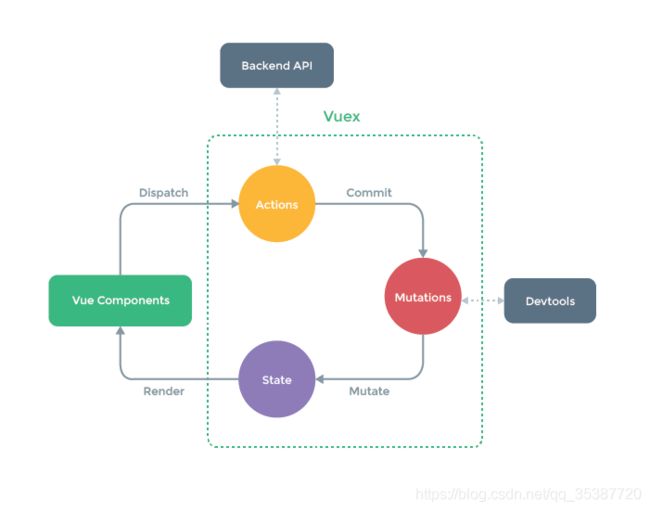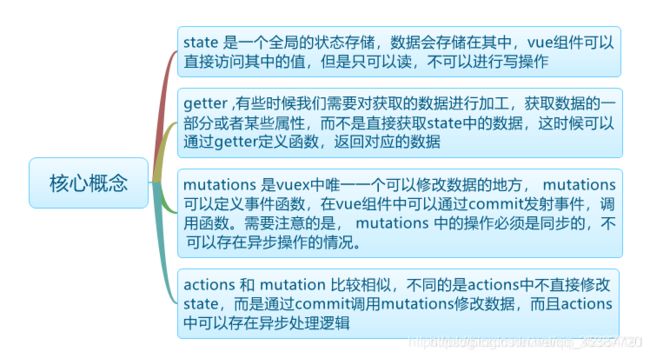Vue核心插件之Vuex
简介
Vuex 是一个专为 Vue.js 应用程序开发的状态管理模式,统一存储管理和维护所有组件的可变化状态。
应用背景:
- 多层嵌套的组件或者兄弟组件需要共享同一状态
- 多层嵌套的组件或者兄弟组件通讯,需要变更状态
- 如果应用够简单,不建议使用vuex, 一个简单的store 模式就能满足所需;如果构建一个中大型单页应用,想要更好地在组件外部管理状态,Vuex 将会成为自然而然的选择.

核心概念
每一个 Vuex 应用的核心就是 store(仓库)。“store”基本上就是一个容器,它包含着你的应用中大部分的状态 (state)。Vuex 和单纯的全局对象有以下两点不同:
-
vuex的状态存储是响应式的.当 Vue 组件从 store 中读取状态的时候,若 store中的状态发生变化,那么相应的组件也会相应地得到高效更新。
-
不能直接更改store中的状态. 改变store中状态的唯一途径就是显式地提交 (commit)mutation
如下:// 如果在模块化构建系统中,请确保在开头调用了 Vue.use(Vuex) import Vue from 'vue' import Vuex from 'vuex' import createLogger from 'vuex/dist/logger' // 使用插件 Vue.use(Vuex) export default new Vuex.Store({ state: { count: 0 }, mutations: { increment (state) { state.count++ } } // 打印日志观察流程 plugins: process.env.NODE_ENV !== 'production' ? [createLogger()] : [] }) // 变更状态 store.commit('increment') // 查询状态 console.log(store.state.count) // -> 1
State
Vuex 使用单一状态树,即用一个对象就包含了全部的应用层级状态.
- 获取状态:
-
Vuex 通过 store 选项,提供了一种机制将状态从根组件“注入”到每一个子组件中(需调用 Vue.use(Vuex)):
import Vue from 'vue' import App from './App' // store import store from '@/store/index' // 菜单和路由设置 import router from './router' new Vue({ router, store, render: h => h(App) }).$mount('#app') // 查询状态 this.$store.state.count -
获取状态
通过在根实例中注册 store 选项,该 store 实例会注入到根组件下的所有子组件中,且子组件能通过 this.$store 访问到computed: { count () { return this.$store.state.count } }
- mapState 辅助函数
当一个组件需要获取多个状态时候,将这些状态都声明为计算属性会有些重复和冗余, 使用 mapState 函数帮助我们生成计算属性.
mapState 函数返回的是一个对象。我们需要使用工具函数(对象展开运算符)将多个对象合并为一个,以使我们可以将最终对象传给 computed 属性.import { mapState } from 'vuex' computed: { // 使用对象展开运算符将此对象混入到外部对象中 ...mapState({ // ... }), localComputed () { /* ... */ }, }
Getter
有时候我们需要从 store 中的 state 中派生出一些状态,例如对列表进行过滤并计数:
computed: {
doneTodosCount () {
return this.$store.state.todos.filter(todo => todo.done).length
}
}
Vuex 允许我们在 store 中定义“getter”(可以认为是 store 的计算属性)。就像计算属性一样,getter 的返回值会根据它的依赖被缓存起来,且只有当它的依赖值发生了改变才会被重新计算。
Getter 接受 state 作为其第一个参数:
const store = new Vuex.Store({
state: {
todos: [
{
id: 1, text: '...', done: true },
{
id: 2, text: '...', done: false }
]
},
getters: {
doneTodos: state => {
return state.todos.filter(todo => todo.done)
}
}
})
-
通过属性访问
Getter 会暴露为 store.getters 对象,可以以属性的形式访问这些值:store.getters.doneTodos // -> [{ id: 1, text: '...', done: true }] // Getter 也可以接受其他 getter 作为第二个参数: getters: { // ... doneTodosCount: (state, getters) => { return getters.doneTodos.length } } // 访问 computed: { doneTodosCount () { return this.$store.getters.doneTodosCount } }注意: getter 在通过属性访问时是作为 Vue 的响应式系统的一部分缓存其中的。
-
通过方法访问
也可通过让 getter 返回一个函数,来实现给 getter 传参。在你对 store 里的数组进行查询时非常有用getters: { // ... getTodoById: (state) => (id) => { return state.todos.find(todo => todo.id === id) } } // 访问 store.getters.getTodoById(2) // -> { id: 2, text: '...', done: false }注意: getter 在通过方法访问时,每次都会去进行调用,而不会缓存结果。
-
mapGetters 辅助函数
mapGetters 辅助函数仅仅是将 store 中的 getter 映射到局部计算属性:import { mapGetters } from 'vuex' export default { computed: { // 使用对象展开运算符将 getter 混入 computed 对象中 ...mapGetters([ 'doneTodosCount', 'anotherGetter' ]) } } // 如果你想将一个 getter 属性另取一个名字,使用对象形式: mapGetters({ // 把 `this.doneCount` 映射为 `this.$store.getters.doneTodosCount` doneCount: 'doneTodosCount' })
Mutation
更改 Vuex 的 store 中的状态的唯一方法是提交 mutation。每个 mutation 都有一个字符串的 事件类型 (type) 和 一个 回调函数 (handler)。这个回调函数就是我们实际进行状态更改的地方,并且它会接受 state 作为第一个参数.
注: 在 Vuex 中,mutation 都是同步事务:
const store = new Vuex.Store({
state: {
count: 1
},
mutations: {
increment (state) {
// 变更状态
state.count++
}
}
})
你不能直接调用一个 mutation handler。“当触发一个类型为 increment 的 mutation 时,调用此函数。”要唤醒一个 mutation handler,你需要以相应的 type 调用 store.commit 方法:
store.commit('increment')
-
提交载荷(Payload)
向 store.commit 传入额外的参数,即 mutation 的 载荷(payload)
在大多数情况下,载荷应该是一个对象,这样可以包含多个字段:mutations: { increment (state, payload) { state.count += payload.amount } } store.commit('increment', { amount: 10})提交 mutation 的另一种方式是直接使用包含 type 属性的对象:
store.commit({ type: 'increment', amount: 10}) mutations: { increment (state, payload) { state.count += payload.amount } } -
Mutation 需遵守 Vue 的响应规则
1.提前在 store 中初始化好所有所需属性
2.当需要在对象上添加新属性时,你应该:
// 新增 Vue.set(obj, 'newProp', 123), // 替换(利用对象展开运算符) state.obj = { ...state.obj, newProp: 123 } -
使用常量替代 Mutation 事件类型
// mutation-types.js export const SOME_MUTATION = 'SOME_MUTATION' import Vuex from 'vuex' import { SOME_MUTATION } from './mutation-types' const store = new Vuex.Store({ state: { ... }, mutations: { // 我们可以使用 ES2015 风格的计算属性命名功能来使用一个常量作为函数名 [SOME_MUTATION] (state) { // mutate state } } }) -
在组件中提交 Mutation
你可以在组件中使用 this.$store.commit(‘xxx’) 提交 mutation,或者使用 mapMutations 辅助函数将组件中的 methods 映射为 store.commit 调用(需要在根节点注入 store)。import { mapMutations } from 'vuex' export default { methods: { ...mapMutations([ 'increment', // 将 `this.increment()` 映射为 `this.$store.commit('increment')` // `mapMutations` 也支持载荷: 'incrementBy' // 将 `this.incrementBy(amount)` 映射为 `this.$store.commit('incrementBy', amount)` ]), ...mapMutations({ add: 'increment' // 将 `this.add()` 映射为 `this.$store.commit('increment')` }) } }
Action
Action 提交的是 mutation,而不是直接变更状态; Action 可以包含任意异步操作
const store = new Vuex.Store({
state: {
count: 0
},
mutations: {
increment (state) {
state.count++
}
},
actions: {
//increment (context) {
//context.commit('increment')
// }
// es6的参数解构简化代码
increment ({
commit }) {
commit('increment')
}
}
})
Action 函数接受一个与 store 实例具有相同方法和属性的 context 对象, 可以调用 context.commit 提交一个 mutation,或者通过 context.state 和 context.getters 来获取 state 和 getters。可用es6的参数解构简化代码
-
触发Action
Action 通过 store.dispatch 方法触发:store.dispatch('increment') actions: { incrementAsync ({ commit }) { // 异步操作 setTimeout(() => { commit('increment') }, 1000) } }Actions 与mutation一样, 支持同样的载荷方式和对象方式进行分发:
actions: { checkout ({ commit, state }, products) { // 把当前购物车的物品备份起来 const savedCartItems = [...state.cart.added] // 发出结账请求,然后乐观地清空购物车 commit(types.CHECKOUT_REQUEST) // 购物 API 接受一个成功回调和一个失败回调 shop.buyProducts( products, // 成功操作 () => commit(types.CHECKOUT_SUCCESS), // 失败操作 () => commit(types.CHECKOUT_FAILURE, savedCartItems) ) } }注意我们正在进行一系列的异步操作,并且通过提交 mutation 来记录 action 产生的副作用(即状态变更)
-
在组件中分发 Action
在组件中使用 this.$store.dispatch(‘xxx’) 分发 action,或者使用 mapActions 辅助函数将组件的 methods 映射为 store.dispatch 调用(需要先在根节点注入 store):import { mapActions } from 'vuex' export default { methods: { ...mapActions([ 'increment', // 将 `this.increment()` 映射为 `this.$store.dispatch('increment')` // `mapActions` 也支持载荷: 'incrementBy' // 将 `this.incrementBy(amount)` 映射为 `this.$store.dispatch('incrementBy', amount)` ]), ...mapActions({ add: 'increment' // 将 `this.add()` 映射为 `this.$store.dispatch('increment')` }) } } -
组合Action
Action 通常是异步的,那么如何知道 action 什么时候结束呢?更重要的是,我们如何才能组合多个 action,以处理更加复杂的异步流程?
首先,你需要明白 store.dispatch 可以处理被触发的 action 的处理函数返回的 Promise,并且 store.dispatch 仍旧返回 Promise:
// 假设 getData() 和 getOtherData() 返回的是 Promise // async await 是promise的语法糖 actions: { async actionA ({ commit }) { commit('gotData', await getData()) }, async actionB ({ dispatch, commit }) { await dispatch('actionA') // 等待 actionA 完成 commit('gotOtherData', await getOtherData()) } }一个 store.dispatch 在不同模块中可以触发多个 action 函数。在这种情况下,只有当所有触发函数完成后,返回的 Promise 才会执行。
Module
当应用比较复杂, 所有状态会集中成较大的对象时,Vuex 允许将 store 分割成模块(module)。每个模块拥有自己的 state、mutation、action、getter、甚至是嵌套子模块——从上至下进行同样方式的分割:
const moduleA = {
state: {
... },
mutations: {
... },
actions: {
... },
getters: {
... }
}
const moduleB = {
state: {
... },
mutations: {
... },
actions: {
... }
}
const store = new Vuex.Store({
modules: {
a: moduleA,
b: moduleB
}
})
store.state.a // -> moduleA 的状态
store.state.b // -> moduleB 的状态
更多详情…
Vuex 规则
- 应用层级的状态应该集中到单个 store 对象中
- 提交 mutation 是更改状态的唯一方法,并且这个过程是同步的
- 异步逻辑都应该封装到 action 里面
参考实例
购物车实例
